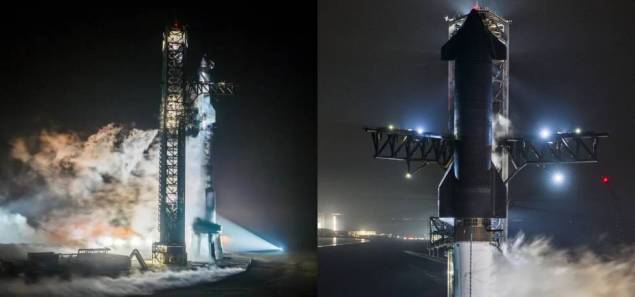SpaceX said in a social media post Wednesday that it plans to launch its huge Starship rocket for the third time as soon as March 14.
SpaceX is still waiting for the Federal Aviation Administration to give its OK for the launch. If they don’t, Starship will stay on the ground. But even though the FAA hasn’t given SpaceX the go-ahead for the next flight yet, there are signs that the company has been waiting for it and will soon. Teams at the Starbase facility in southwest Texas finished a very important “wet dress” practice for launch this past weekend. They loaded the nearly 400-foot-tall rocket with more than 10 million pounds of fuel and practiced the countdown to T-minus 10 seconds.
The FAA also confirmed at the end of last month that its investigation into SpaceX’s second Starship launch was complete. At the time, regulators said that the company had to finish 17 “corrective actions” before they could issue a new launch license. The company should meet its March 14 goal date as long as those are signed off on within the next week.
For seven months, SpaceX put off the second test of Starship’s orbital flight until November of last year. The first test took place in April of last year. The Super Heavy rocket and the upper stage (also known as Starship) exploded in the air at the end of both. Even though the results were so bad, the second test went much further than the first. The company demonstrated a number of key technologies that it couldn’t do in the first test.
The company definitely wants to keep that up, but this third test adds a few new, very challenging goals. These include demonstrating fuel transfer during the Starship upper stage’s coasting phase and starting a Raptor engine again for the first time ever in space. Transferring propellant is one of the most important skills the company needs to get right in order to finish its multibillion-dollar trips to the moon for NASA.
Most of the time, the next launch will have the same general mission profile. The following should be the order of events if everything goes as planned: In a new “hot staging” separation method, the upper stage lights its engines to push the booster away. This will happen soon after launch, separating the Super Heavy rocket from the Starship. After its own “boost back burn,” which is like how Falcon 9 rockets come back to Earth, that booster will splash down in the Gulf of Mexico.
The top stage of the Starship will keep going up to orbit in the meantime. As soon as it hits orbital speed, it will turn off its engine and fly almost all the way around the world before landing in the ocean. This time, unlike the first two flights, the company will try a different path that would land Starship in the Indian Ocean instead of the Pacific Ocean near Hawaii in order to try to restart the Raptor engine in space.
SpaceX says on its website that this trip is part of a test program that lets the company get information about how the vehicle works in real flight.
Also Read: The US Government Will Not Give SpaceX’s Starlink Business Another $900 Million In Subsidies
The company says that all of SpaceX’s big technological advances, such as Falcon, Dragon, and Starlink, are based on this rapid iterative development approach. “Improving things over and over again is important as we try to create a transportation system that can take both people and things to Earth orbit, help people get back to the Moon, and eventually go to Mars and beyond.”
What do you say about this story? Visit Parhlo World For more.


